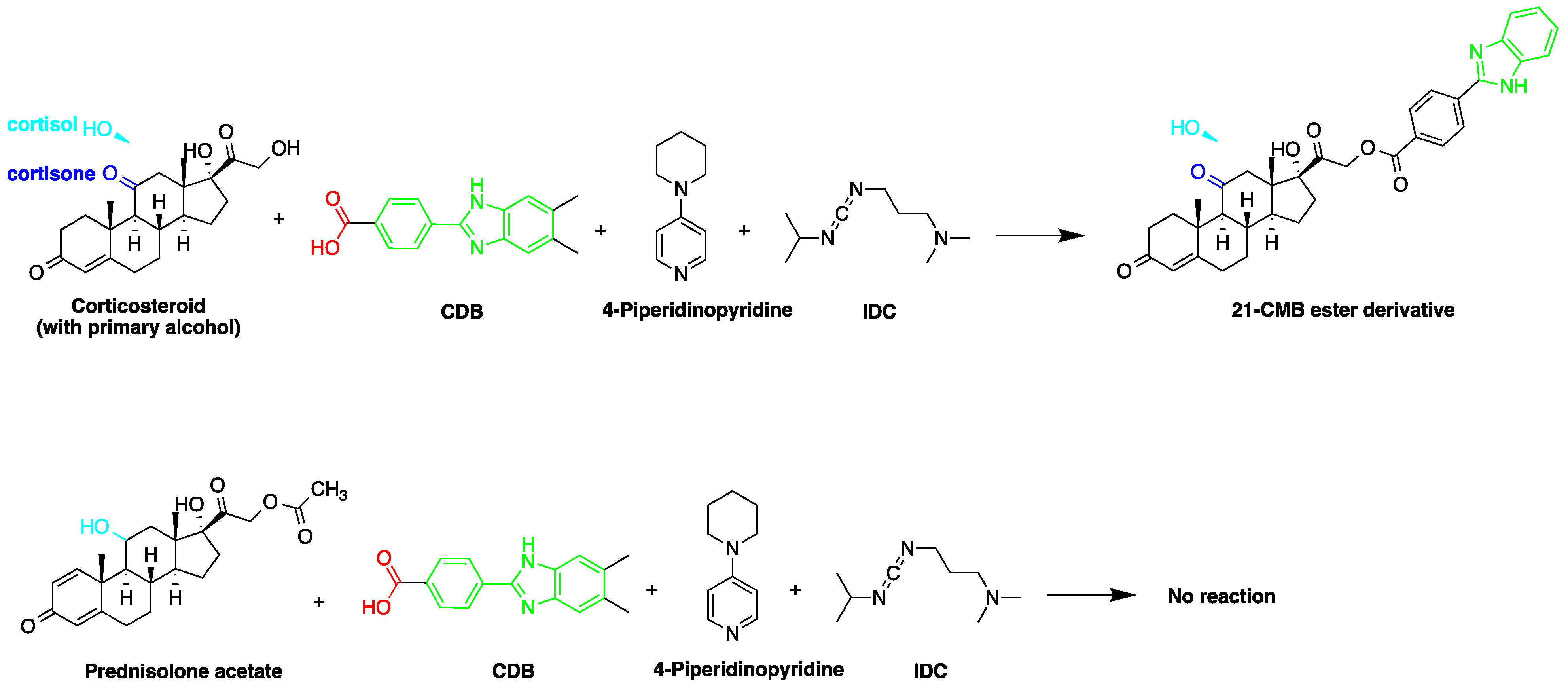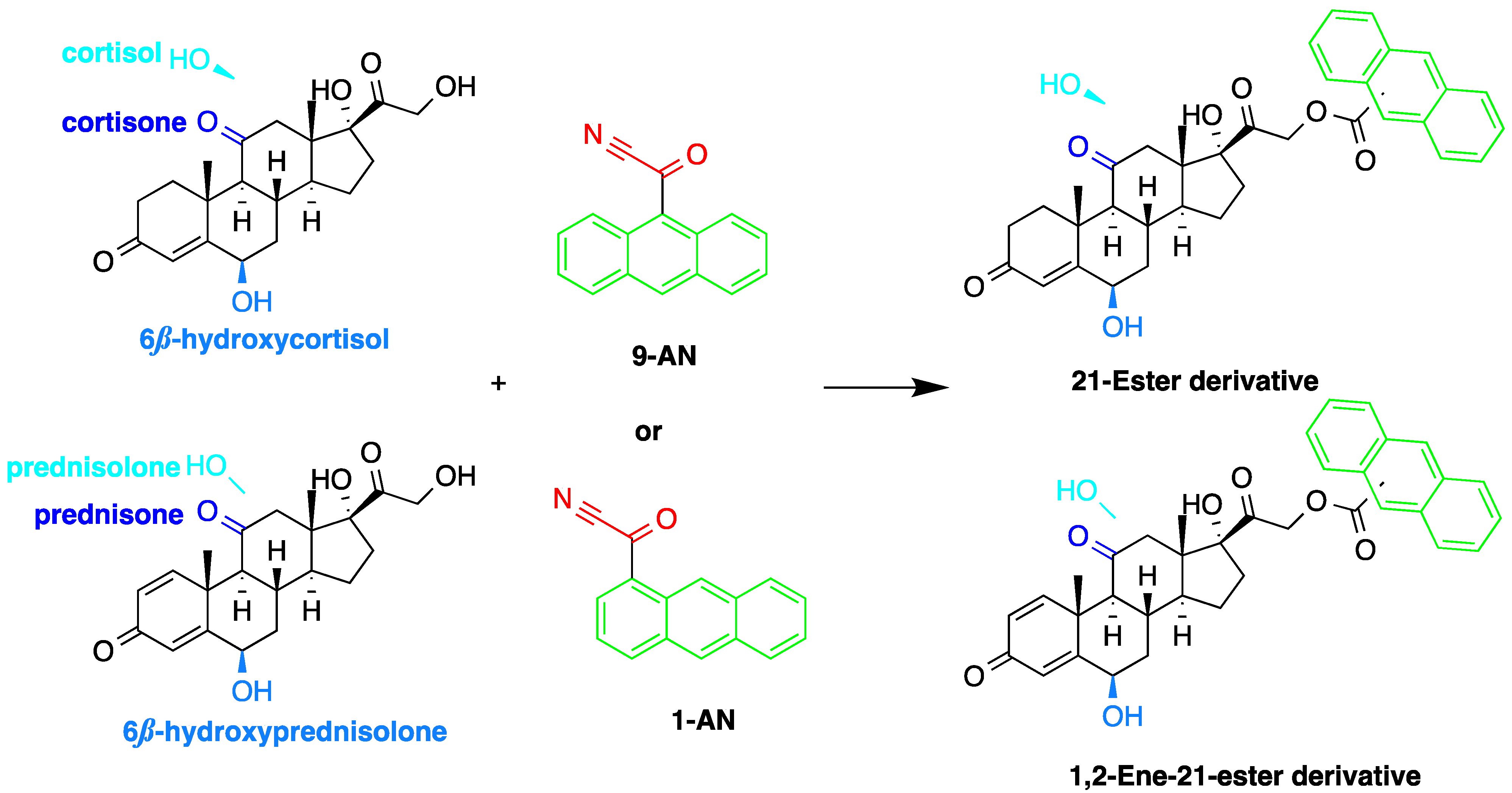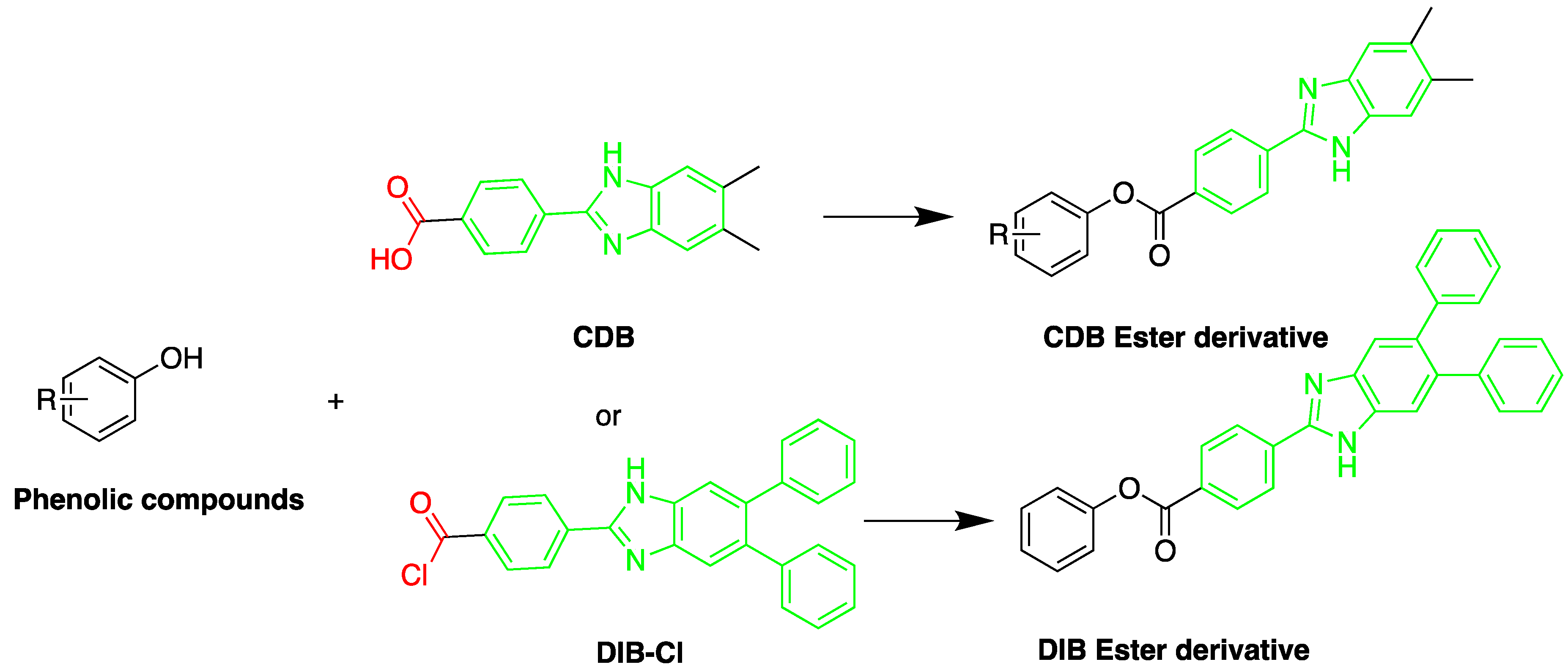1000/1000
Hot
Most Recent

| Version | Summary | Created by | Modification | Content Size | Created at | Operation |
|---|---|---|---|---|---|---|
| 1 | Aref Zayed | -- | 4838 | 2022-04-08 11:06:10 | | | |
| 2 | Conner Chen | -4 word(s) | 4834 | 2022-04-11 04:57:54 | | | | |
| 3 | Conner Chen | Meta information modification | 4834 | 2022-04-11 04:59:26 | | | | |
| 4 | Conner Chen | Meta information modification | 4834 | 2022-04-11 05:14:41 | | |
Steroids are compounds widely available in nature and synthesized for therapeutic and medical purposes. Although several analytical techniques are available for the quantification of steroids in clinical samples, their analysis is challenging due to their low levels and complex matrices. The efficiency and quick separation of the high performance liquid chromatography (HPLC) combined with the sensitivity, selectivity, simplicity, and cost-efficiency of fluorescence, make HPLC coupled to fluorescence detection (HPLC-FLD) an ideal tool for routine measurement and detection of steroids for clinical and medical applications.













| Detected Steroids | Sample Type | Column Chemistry | Mobile Phase (v/v) | Derivatization Agent | Excitation (λex) and Emission Wavelengths (λem) (nm) | Extraction Method | LOD | References |
|---|---|---|---|---|---|---|---|---|
| PL and PN |
Human plasma | C18 | MeOH:ACN:1.0 M ammonium acetate (38:25:45) | DMB | 350, 390 | LLE | 3 ng/mL | Yamaguchi et al. 1991 [18] |
| F and E | Biological samples | Keystone Hypersil | H2O:MeOH:ACN (50:33.3:16.7) | 9-AN | 305–395, 430–470 | SPE | F: 50 pg E: 70 pg |
Haegele et al. 1991 [36] |
| F | Human serum | C18 | 1: 10 mM potassium biphthalate 2: ACN Tetrahydrofuran: 19 mM potassium biphthalate (40:6:54) Both adjusted to pH 1.85 with trifluoroacetic acid |
Sulfuric acid-ethanol | 365, 520 | - | 0.30 pg/dL | Nozaki et al. 1991 [5] |
| F | Human urine | C18 | Gradient of ACN: 36.4 mmol/L phosphate (45:55; pH 1.85 with trifluoroacetic acid) |
Sulfuric acid-ethanol | 365, 520 | SPE | 0.26 pg/dL | Nozaki et al. 1992 [6] |
| 7α-Hydroxycholesterol | Dog plasma | Develosil Ph-5 | Acetonitrile: Water (5:2) |
1-AN | 338, 411 | LLE | 4 pg | Saisho et al. 1998 [20] |
| Corticosteroids | Urine | Silica | 2-Propanol–hexane | 9-AN | 370, 470 | Enzyme hydrolysis, extraction with 0.5 M NaOH | NR | Neufeld et al. 1998 [11] |
| F and E | Human plasma | C18 | ACN: 0.3 mM ortho-phosphoric acid (470:530) | 9-AN | 360, 460 | SPE | 3.0 ng/mL | Glowka et al. 2009 [12] |
| Corticosterone | Rat urine | CN | ACN: H2O (24.5:75.5) | post-column reaction with sulfuric acid |
460, 510 | LLE | 0.5 pmol | Sudo et al. 1990 [3] |
| F | Human hair | C18 | MeOH:H2O 60:40 |
sulfuric acid | 360, 480 | LLE | 1 pg/mg | Gao et al. 2010 [2] |
| EE2, E2, and BPA | Human urine and aqueous samples | C18 | ACN:MeOH:H2O (30:15:55) | - | 280, 310 | FPSE | E2: 20 pg/mL EE2: 36 pg/mL BPA: 42 pg/mL |
Kumar et al. 2014 [23] |
| BPA, NP, E2, EE2, and E3 | Human urine | C18 | Gradient elution of ACN and H2O | p-nitrobenzoyl chloride | E2, E3: 282, 315 BPA, NP, EE2: 228, 316 |
SPE | BPA and E2: 2.7 μg/L NP: 2.9 μg/L E2 and EE2: 4.6 μg/L E3: 8.3 μg/L |
Mao et al. 2004 [22] |
| E, testosterone, methyltestosterone, bolasterone, testosterone acetate, progesterone | Urine | C18 | 0.01 M Tb(NO3)3, 0.1 M sodium dodecyl sulfate (SDS), and 20% acetonitrile |
- | 245, 547 | SPE | Down to 100 pg/mL | Amin et al. 1993 [26] |
| BPA and 8 alkylphenols (4-sec-Butylphenol, 2-tert-Butylphenol, 3-tert-butylphenol, 4-tert-butylphenol, 4-n-Pentylphenol, 4-tert-pentylphenol, 4-n-hexylphenol, and 4-n-heptylphenol) |
Rat plasma and blood | C18 | MeOH:Water (10:90) | 2-(4-carboxyphenyl)-5,6- dimethylbenzimidazole |
Derivatized: 336, 440 Native: 275, 315 |
LLE | BPA: 0.1 pg/mL Alkylphenol: 0.7–10 pg/mL |
Katayama et al. 2001 [35] |
| progesterone and 17-hydroxyprogesterone dehydroepiandrosterone, androstenedione, testosterone and 17-methyltestosterone |
Serum from pregnant and non-pregnant women | Wakosil 5C4 | Acetonitrile:Water (7:3) | BODIPY FL hydrazide | 495, 516 | LLE | 550–3700 fmol per 10 μL | Katayama et al. 1998 [37] |
| aldosterone, corticosterone, F, E, dexamethasone, fluocinolone acetonide, triamcinolone and triamcinolone acetonide |
Human plasma | C18 | Water:MeOH (25:75) containing 5 mmol/L tetramethylammonium hydrogen sulphate | CDB | 334, 418 | LLE | 0.06–0.3 pg per 100 μL | Katayama et al. 1992 [9] |
| BPA | Breast Milk | C18 | 1: ACN:H2O:MeOH (72:13:15) 2: ACN:0.1 M acetate buffer (pH 5.5):MeOH (55:12:33) |
DIB-Cl | 350, 475 | SPE then LLE | 0.11 ng/mL | Sun et al. 2004 [28] |
| BPA | Human blood serum and ascitic fluid samples | C18 | 1: ACN: H2O:MeOH (72:13:15) 2: ACN:0.1 M Acetate buffer (pH 5.5):MeOH (55:12:33) |
DIB-Cl | 350, 475 | LLE | 0.04 ppb | Kuroda et al. 2003 [32] |
| BPA | Rat brain rat plasma |
C18 | 1: ACN: H2O:MeOH:Tetrahydrofuran (55:10:35:2.5) 2: ACN:0.1 M Acetate buffer (pH 3.0):MeOH (35:10:55) |
DIB-Cl | 350, 475 | LLE | 0.3 ppb in 60 μL rat brain 4.6 ppb in 50 μL rat plasma |
Sun et al. 2002 [33] |
| F, E, PL, PN, 6β-OHF, 6β-OHP and 6β-OHE |
Human plasma and urine | Cosmosil 5SL | diethylene dioxide: ethyl acetate:chloroform:n-hexane:pyridine (500:100:100:1400:21) | 9-AN | 360, 460 | LLE | F, E, PL and PN: 0.1 ng/mL 6β-OHF and 6β-OHP: 0.5 ng/mL |
Shibata et al. 1997 [13] |
| Corticosterone | Rat serum | C18 | 60% MeOH: 40% 5 mM triethylamine, pH 3.3 |
- | 375, 485 | LLE | 0.1 ng | Mason et al. 1992 [7] |
| 18-Oxygenated corticosteroids, 18-hydroxycortisol, 18- hydroxycortisone and 18-oxocortisol |
Human urine | μBondasphere phenyl | A: 10 mM ammonium acetate: MeOH (50:50) B: ACN |
1-AN | 370, 470 | LLE and SPE | 0.1 pmol | Kurosawa et al. 1995 [14] |
| Cholesterol and sitosterol | Saliva and urine biosamples, Cow milk, and Soybean milk | C8 | MeOH:isopropanol:H2O (90:5:5) |
naproxen acyl chloride | 231, 352 | LLE | 25 nM per 10 μL injected volume | Lin et al. 2007 [19] |
| Pregnenolone | Rat brain | C18 | MeOH:H2O (9:1) | 1-AN | 370, 470 | SPE | NR | Shimada et al. 1996 [38] |
| C21 steroids; corticoids | Steroid standards | C18 | MeOH:H2O:cyclodextrin | 1-AN | 360, 460 | NR | NR | Shimada et al. 1991 [39] |
| Triamcinolone | Human plasma | C18 | ACN and 0.3 mM ortho-phosphoric acid |
9-AN | 360, 460 | SPE | 1 ng/mL | Glowka et al. 2006 [40] |
| Butane acid-(5-androsten-17-one-3beta-ol)-diester (A1998) | Rat plasma | C18 | 25 mM acetate buffer (pH 3.7):ACN Alfaxalone: (45:55) Pregnanolone: (40:60) |
Dansyl hydrazine | 332, 516 | LLE | 10 ng/mL | Visser et al. 2000 [41] |
| Alfaxalone and pregnanolone | Rat plasma | C18 | Gradient mixture of ACN and H2O |
Dansyl Hydrazine | 350, 520 | - | 0.025 μg/mL | Peng et al. 2007 [42] |
| EED | Oral contraceptive tablets | STAR RP-18e | ACN:H2O (47:53) | - | EED: 285, 310 | - | EED: 0.0538 μg/ml | Sarafinovska et al. 2006 [43] |
| EED and drospirenone | Oral contraceptive tablets | STAR RP-18e RP | ACN:H2O (47:53) | - | 285, 310 | - | EED: 0.00065 μg/mL DROSP: 0.0774 μg/mL |
Sarafinovska et al. 2009 [44] |
| EED | Coated tablets | LiChroCART 100RP | ACN:H2O (50:50) | - | 280, 310 | - | EED: 0.02 μg/mL | Silva et al. 2013 [45] |
| Sodium E1 sulphate, sodium equilin sulphate, E1 and equilin |
Raw materials and Pharmaceuticals |
5 ODS2 | TEA phosphate buffer (pH 4.0; 0.05 M):ACN 1— (70:30, v:v) 2—for unconjugated estrogens: (66:34) |
Postcolumn on line photochemical derivatization | 280, 410 or 312 | - | 0.01–1.38 pmol | Gatti et al. 1998 [46] |
| E1, 17β-Estradiol, E3, BPA, NP, OP |
Fish, chicken, aquaculture pond water sample | C18 | Gradient program of 1: H2O: 5% ACN 2: H2O: ACN |
BCEC-Cl | 279, 380 | DLLME | 0.02–0.07 µg/L | Wu et al. 2015 [47] |
| E1, E2, and E3 |
Cow and river Buffalo | C18 | 1: ACN:H2O:Formic Acid (40:60:0.4) 2: ACN:H2O:Formic Acid (90:10:0.4) |
- | 280, 310 | LLE and SPE | 5–10 ng/kg | Shahbazi et al. 2016 [48] |
| α- and β-Trenbolone | Bovine muscle and liver | C18 | MeOH:H2O (60:40) | - | 364, 460 | LLE then SPE | bovine muscle: 0.2 ng/g liver: 1.0 ng/g |
Yoshioka et al. 2000 [49] |
| NP, 4-nonylphenol mono-(NP1EO), diethoxylates (NP2EO), BPA, TBP, and OP |
Fish and shellfish | Inertsil PH | Gradient program of A: H2O B: MeOH |
- | 275, 300 | LLE | NP NP1EO and NP2EO : 2 ng/g BPA, BP and OP: 1 ng/g |
Tsuda et al. 2000 [24] |
| Nonylphenol and its ethoxylates | Fish tissue | Hypersil APS | Hexane:ethanol (98:2) | - | 230, 300 | Pressurized fluid extraction | 4–15 ng/mL | Datta et al. 2002 [50] |
| E2 and EE2 | Poultry litter | C18 | Gradient program of A: H2O B: ACN |
- | 280, 312 | LLE | E2: 4.0 μg/kg EE2: 2.6 μg/kg |
Lu et al. 2014 [51] |
| E2 and EE2 | Waste Water | C18 | Gradient program of A: H2O B: ACN |
- | 282, 306 | SPE | 2.5 ng/L | Liz et al. 2017 [52] |
| E3, E2, EE2, HEX, mestranol |
Water, sediment | Poroshell 120 EC | H2O:ACN 50:50 | - | 275, 310 | SPE | Water: 6–24 ng/L Sediment: 0.1–0.9 ng/g |
Perez et al. 2015 [53] |
| E2, 17α-EE2, and E1 | Water | C18 | Gradient program of A: ACN B: H2O acidified at pH 3.6 with glacial acetic acid |
- | 230, 302 | SPE | 10 to 1100 ng/L |
Patrolecco et al. 2013 [54] |
| OP, NP, BPA, diethylstilbestrol, E1, EE2, E2, and E3 |
Wastewater samples |
C18 | Gradient program of A: 5% ACN B: ACN |
EASC | 262, 430 | SPE | 0.3–0.7 ng/L | Zhang et al. 2012 [55] |
| E2 and EE2 |
Tap, surface and waste water | C18 | Water:acetonitrile mixture (50:50) | - | 280, 310 | DLLME | E2: 2.0 ng/L EE2: 6.5 ng/L |
Lima et al. 2013 [56] |
| BPA, 17β-estradiol, and 17α-ethynyl estradiol | Drinking water | LiChro-sorbs RP18 | 10 mM H3PO4:55% MeOH (45:55) | - | 280, 310 | PAC | BPA: 201 ng/L E2: 313 ng/L EE2: 284.5 ng/L |
Yoon et al. 2003 [57] |
| 17α- and 17β-Trenbolone | River water | C18 | Gradient program of MeOH:H2O |
- | 359, 458 | SPE | 4 ng/L | Durhan et al. 2005 [58] |
| NP, OP, NP polyethoxylates |
municipal wastewater treatment plants | C18 | Gradient program of H2O:ACN |
- | 229, 310 | LLE | OP: 2 ng/L NP: 11 ng/L NPE: 52 ng/L |
Snyder et al. 1999 [59] |
| E2, E3, BPA, and 17β-ethinylestradiol |
environmental waters |
C18 | ACN:0.02 mol/L phosphate solution (45:55) | - | 227, 315 | Synthesized in-tube SPME device | 0.006–0.10 ng/mL | Wen et al. 2006 [60] |
| E2, E3, EE2, 3-methyl ether EE2, NP, OP, POE(1-2) nonyl phenol and BPA |
River water | C18 | Gradient program of Milli-Q H2O and ACN |
- | 230, 290 | on-line SPE | 20–50 ng/L | Ying et al. 2002 [61] |
| Endocrine disruptors; BPA and EE2 | Environmental water samples | C18 | MeOH:0.025 mol/L Na2HPO4 buffer (70:30) | - | 220, 315 | A poly(acrylamide-vinylpyridine) monolithic capillary column |
BPA: 0.064 ng/mL 17α-ethinylestradiol: 0.12 ng/mL |
Fan et al. 2005 [62] |
| Brassinosteroids | Plant: (Vicia faba L.) |
C18 | ACN: H2O (90:10) | 9-Phenanthreneboronic acid | 305, 375 | LLE | 50 pg | Gamoh et al. 1989 [63] |
| Brassinolide | Arabidopsis thaliana, Daucus carota and Brassica campestris L. leaves’ samples |
C18 | Gradient program of A: H2O and ACN B: ACN and 0.1% Formic Acid |
- | 305, 375 | UA-DLLME | 8.0 ng/L | Lv et al. 2014 [64] |
| Brassinolide and castasterone | Pollen of orange (Citrus sinensis Osbeck) | C18 | ACN:H2O (80:20) | Dansylaminophenylboronic acid |
345, 515 | LLE | NR | Motegi et al. 1994 [65] |
| Norgestrel, norethindrone, EE2, gestodene, and norethisterone acetate | Meat samples | Hypersil GOLD | Gradient program of (A) H2O containing 5% ACN (B)ACN |
Fmoc-Cl | 250, 395 | MSPE | 1.4 × 103–8.7 × 103 | Qianyu Li et al. 2018 [66] |
| F and E | Human urine samples | C18 | ACN:0.3 mM orthophosphoric acid (470: 530) | 9-AN | 360, 460 | LLE | LLOQ: F: 27.6 nmol/L E: 27.7 nmol/L |
Kosicka et al. 2018 [67] |
| FFA | Edible oils and foodstuff | C8 | Gradient system: A: H2O B: ACN/DMF (1:1) C: ACN (100%) |
BCETS | 279, 380 | Supercritical CO2 and organic solvent extraction | 0.22–1.06 ng/mL | Li et al. 2011 [68] |
| OP, NP, TBP, BPA, E1, E2, E3 | Milk samples | C18 | Gradient program of A:5% ACN in H2O B: ACN |
BQEIC | 302, 401 | LLE | 10.5–13.8 ng/L | Liu et al. 2018 [69] |
| E3, 2-OHE2, 17β-E2, 17α-E2, EE2, HEX | Dairy products | C18 | Gradient Flow A: 1 mM formic acid in ACN B: 1 mM formic acid at pH 3.50 |
- | 280, 310/320 | HF-LPME | 0.23–14.8 μg/kg | Bárbara Socas-Rodríguez et al. 2014 [70] |
| Zearalenone | Edible oil | C18 | Gradient program of A: H2O, B: ACN |
274, 456 | SPE | 10 μg/kg | Drzymala et al. 2015 [71] | |
| EE2, E1, E2, E3, and progesterone | Drinking water and wastewater samples | C18 | Gradient program of A: H2O/CH3CN 90/10 v/v B: CH3CN |
200, 315 | SPE | Drinking water: 1–3.8 ng/L Sewage water: 3.8–7.5 ng/L |
Kozłowska-Tylingo et al. 2015 [72] | |
| E3, E2, E1 | Human urine | C18 | Gradient program of A: H2O, B: ACN |
280, 310 | VA-DLLME-FOA | E3: 0.01 ng/mL β-E2: 0.01 ng/mL E1: 0.06 ng/mL |
Wang et al. 2015 [25] | |
| 17-α-E2, 17-β-E2 benzoate and quinestrol |
Environmental water samples | Zorbax Eclipse SB-C18 | Gradient program of A: ACN, B: H2O |
265, 311 | IF-IHLME | 17-α-Estradiol: 0.04 ng/mL E2 and Quinestrol: 0.05 ng/mL |
Zhang et al. 2017 [73] | |
| E2 and EE2 | Tap water samples | Pursuit 5 C18 column | ACN:H2O (50:50), with 200 μL of H3PO4 | 230, 306 | Nanoparticles of graphene oxide/γ-Fe2O3 as a sorbent for SPE |
E2: 2.7 ng/L EE2: 0.8 ng/L |
Fernanda Nunes Ferreira et al. 2020 [74] | |
| 17-E2 and E3 | Water samples | C18 | H2O:MeOH:ACN (50:30:20) |
280, 310 | ultrasonication assisted DLLME | DLLME-HPLC/FLD: 7.16–69.22 ng/L | Zhang et al. 2020 [75] | |
| E2, 1,3,5(10)-Estratriene-3,17β-diol | Fish and prawn tissue samples | ODS C18 | H2O:MeOH (30:70) | 280,310 | MISPE | 0.023 mg/L | Jiang et al. 2009 [76] | |
| BPA, EE2, 4-t- OP, 4-OP, and 4-NP |
River water | C18 | Gradient program of A: ACN B: H2O |
277, 307 | Disposable pipette extraction (DPX) | BPA, EE2, 4-OP and 4-NP: 0.30 μg/L 4-t-OP: 0.60 μg/L |
Gabriela Corazza et al. 2017 [77] | |
| E1 and EE2 | Digested sludge | C18-PFP | A: H2O B: ACN E1: (50:50) EE2 (55:45) |
280, 310 | ultrasonic liquid extraction | E1: 0.305 μg/g EE2: 0.052 μg/g |
Vitória L. Louros et al. 2019 [78] | |
| E2 | Milk sample | XDB-C18 | MeOH:H2O (70:30) |
280, 310 | SPE | 0.7 ng/mL | Yanan Yuan et al. 2019 [79] | |
| Nine BPs | milk samples | C18 | Gradient program of 0.1% formic acid: ACN |
230, 305 | ultrasonically with acetonitrile and cleaned using the QuEChERS technique. |
1.0–3.1 µg/kg | Xiong et al. 2017 [80] | |
| EE | river water samples | 5C18 MS-II | ACN: 5.0 mM Tris-HNO3 buffer, pH 7.4 (60:40) | 310, 400 | C18 SPE disk | 7.4 ng/L | Ali et al. 2020 [81] | |
| E3, 17β-estradiol glucuronide, 17β-E2, 17α-E2, 17β-E2-3-methyl ether |
wastewater | UPLC C18 | Gradient program of water with 0.1% of ammonia: ACN |
280, 310 | Molecularly Imprinted SPE | 1.4 to 2.5 ng/mL | Rayco Guedes-Alonso et al. 2015 [82] |